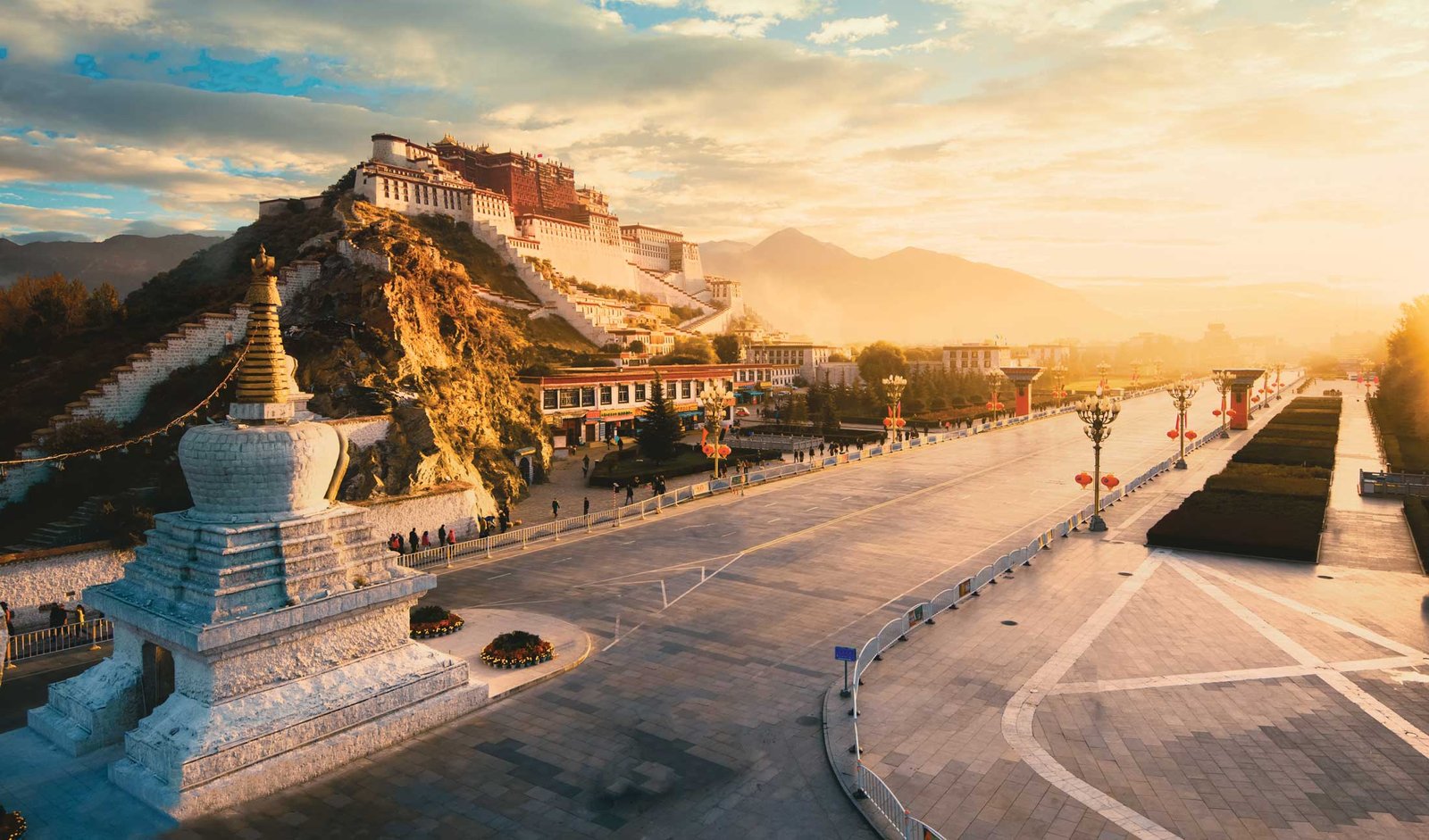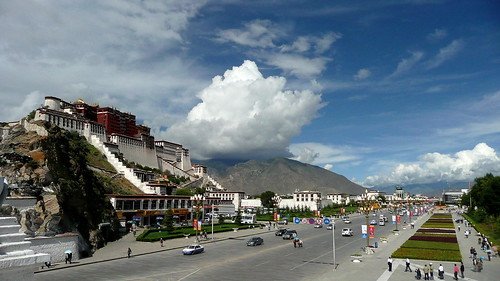Nestled in the heart of the Tibetan Plateau, Lhasa, the capital city of Tibet, stands as a testament to the region’s rich cultural heritage and spiritual significance. With a history spanning over 1,300 years, Lhasa has served as a political, religious and cultural center for the Tibetan people. Set against a backdrop of towering mountains and sweeping valleys, the city’s breathtaking natural beauty further enhances its allure.

Lhasa’s spiritual significance is deeply rooted in Tibetan Buddhism. The Jokhang Temple, considered the most sacred shrine in Tibet, is believed to have been built in the 7th century and enshrines the Jowo Shakyamuni statue, a revered image of the Buddha. Pilgrims from far and wide flock to this temple to offer their prayers and seek blessings, creating an atmosphere of profound devotion.

Another architectural marvel is the Potala Palace, the former residence of the Dalai Lama and a UNESCO World Heritage Site. The palace’s imposing presence dominates the city skyline, and its intricate architecture reflects the fusion of Tibetan and Chinese design elements. The Potala Palace houses numerous valuable artifacts, including murals, religious scriptures, and historical relics, providing a glimpse into Tibet’s rich cultural legacy.

Beyond its religious landmarks, Lhasa boasts a vibrant local culture. Barkhor Street, a bustling pedestrian walkway encircling the Jokhang Temple, is a feast for the senses, lined with shops selling traditional Tibetan handicrafts, souvenirs, and prayer wheels. The street comes alive during the annual Saga Dawa festival in June, where Tibetans engage in a devotional walk known as the “kora” and engage in traditional performances showcasing Tibet’s rich cultural heritage, providing visitors with a unique opportunity to immerse themselves in local traditions.
Lhasa’s culinary delights also offer a tantalizing blend of local flavors and influences. From hearty noodle soups like thukpa to flavorful yak meat momos (dumplings) and traditional Tibetan bread known as “tsampa,” the city’s cuisine reflects the diverse cultural interactions that have shaped the region over centuries.
Getting to Lhasa can be an adventure in itself, with options including scenic train journeys or spectacular flights offering panoramic views of the Tibetan landscape. Within the city, visitors can explore its many attractions on foot or hire a local guide for a more in-depth exploration, gaining insights into the hidden gems and stories that make Lhasa such a captivating destination.
Despite recent modernization efforts, Lhasa’s ancient traditions and customs remain firmly rooted in the hearts of its people, offering visitors a glimpse into a world steeped in spirituality, natural beauty, and cultural richness. In Lhasa, the past harmoniously intertwines with the present, making it a city of captivating contrasts and enduring allure.# The Heart Of Tibet: An In-depth Look at the Tibetan Capital City
Executive Summary
This article provides an in-depth review of the shimmering Tibetan capital, Lhasa, unveiling its rich history, enthralling cultural tapestry, and sacred landmarks. Embark on a journey into the heart of Tibet and uncover the captivating allure that awaits.
Lhasa: A City Enshrined In History
Lhasa, the irradiant capital of Tibet, is a city that pulsates with history. From the 7th century, it has flourished as the nerve center of Tibetan civilization. Delve into the depths of time and marvel at the enduring legacy of Tibetan kings, the omnipotence of the Dalai Lamas, and the struggles against external forces.
Potala Palace: Towering over Lhasa, the awe-inspiring Potala Palace is a testament to the grandeur of Tibetan architecture and a symbol of the city’s regal past.
Jokhang Temple: Revered as the most sacred Buddhist temple in Tibet, the Jokhang Temple is a pilgrimage site of paramount importance, adorned with exquisite murals and sacred relics.
Norbulingka Palace: Stroll through the tranquil gardens and palaces of the Norbulingka Palace, a former summer residence of the Dalai Lamas, offering serenity and a blend of Tibetan and Chinese architectural styles.
Sera Monastery: Embark on a journey of spiritual exploration at the Sera Monastery, renowned for its vibrant tapestry of monks actively engaged in monastic debates and daily rituals.
Drepung Monastery: Discover the architectural splendor and historical significance of the Drepung Monastery, once the world’s largest monastery, adorned with murals, intricate carvings, and an assembly hall that echoes with spiritual harmony.
Exploring the Essence of Tibetan Culture
Lhasa’s cultural tapestry is woven with the essence of Tibetan traditions, artistry, and religious practices. Immerse yourself in this vibrant artistry, awe-inspiring architecture, and the beating pulse of spiritual life.
Tibetan Art and Crafts: Unearth the exquisite beauty of Tibetan handicrafts, renowned for their intricacy and traditional motifs, including colorful carpets, intricate silver jewelry, and vibrant thangkas.
Tibetan Cuisine: Indulge in the culinary delights of Tibetan cuisine, where influences from the Himalayas, China, and Nepal blend harmoniously. Savor momo dumplings, thenthuk noodles, and yak butter tea.
Tibetan Music and Dance: Experience the mesmerizing melodies and spirited performances of Tibetan music and dance, a captivating fusion of melodious chanting, rhythmic drumming, and vibrant costumes.
Unveiling Sacred Landmarks of Tibetan Buddhism
Lhasa is adorned with sacred sites that embody the essence of Tibetan Buddhism. Peel back the layers of history and immerse yourself in the spiritual sanctuary that beckons pilgrims from around the world.
Barkhor Street: Wander along the labyrinthine alleys of Barkhor Street, a circumambulation path encircling the Jokhang Temple, lined with bustling shops, pilgrim stalls, and sacred relics.
Lhasa Shoton Festival: Witness the grandeur of the Lhasa Shoton Festival, an annual celebration showcasing Tibetan opera performances, traditional archery competitions, and vibrant street parades.
Buddhist Pilgrimage: Undertake an inspiring journey along the sacred pilgrimage routes of Lhasa, passing through ancient temples, serene monasteries, and remote mountain passes.
A Touch of Modernity in the Mystic City
Amidst the historic grandeur, Lhasa has embraced a touch of modernity, blending seamlessly with its traditional Tibetan charm. Step into a world where ancient heritage meets contemporary progress.
Lhasa Nightlife: Discover the vibrant energy pulsing through Lhasa’s evolving nightlife scene, marked by chic rooftop bars, karaoke lounges, and traditional Tibetan music venues.
Shopping in Lhasa: Embark on a shopping expedition through Lhasa’s bustling markets and modern shopping malls, offering an array of Tibetan handicrafts, souvenirs, and contemporary fashion.
Accommodation and Dining: Choose from a diverse range of accommodation options, from traditional guesthouses to modern hotels, catering to a variety of tastes and budgets. Sample delectable Tibetan cuisine and international fare at restaurants scattered throughout the city.
Conclusion
Lhasa, the heart of Tibet, is a symphony of history, culture, and spirituality. Its sacred landmarks, cultural heritage, and modern developments create an intricate tapestry that beckons travelers from around the world. Lhasa’s profound beauty and timeless allure continue to captivate souls, offering an unforgettable voyage into the heart of Tibet.
Keyword Phrase Tags
- Lhasa Tibet
- Tibetan Culture
- Buddhist Pilgrimage Sites
- Potala Palace
- Tibetan Festivals
